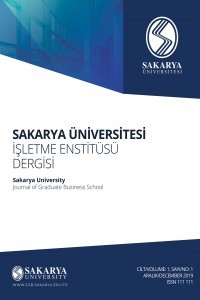Capital structure of enterprises as a factor of ensuring financial stability
Financial Stability, Capital Structure, Intellectual Capital, Financial Stability of the Enterprise
Capital structure of enterprises as a factor of ensuring financial stability
financial stability , intellectual capital, capital structure, financial stability of the enterprise,
___
- 1. Bayburina, E., & Golovko, T. (2008). An empirical study of the intellectual value of large Russian companies and its growth factors. Corporate Finance, 2, 5–19.
- 2. Bazilinsjka, O. Ja. (2009). Financial analysis: theory and practice. Kyjiv: Centr uchbovoji literatury.
- 3. Blank, I. A. (2004). Fundamentals of financial management. Kiev: Nika-Center, Elga.
- 4. Bontis, N., Keow, W. & Richardson, S. (2000). Intellectual Capital and Business Performance in Malaysian Industries. Journal of Intellectual Capital, 1(1), 85–100.
- 5. Bontis, N. (2003). Assessing Knowledge Assets: A review of models used to measure intellectual capital. International Journal of Management Reviews, 3 (1), 41-60.
- 6. Brealey, R., Myers, S., & Allen, F. (2014). Principles of corporate finance. New York: McGraw-Hill Irwin.
- 7. Di'ez, J.M., Ochoa, M.L., Prieto, M.B. & Santidria'n, A. (2010). Intellectual capital and value creation in Spanish firms. Journal of Intellectual Capital, 11(3), 348–367.
- 8. Garanina, T.A. (2008). The structure of intellectual capital: issues of assessment and empirical analysis. Bulletin of St. Petersburg State University, 8(1), 96–118.
- 9. Gruian, C.-M. (2011). The influence of intellectual capital on Romanian companies' financial performance. Annales Universitatis Apulensis Series Oeconomica, 13(2), 260–272.
- 10. Kamath, G.B. (2008). Intellectual capital and corporate performance in Indian pharmaceutical industry. Journal of Intellectual Capital, 9(4), 684–704.
- 11. Komarov, I. (2000). Intellectual capitalism. Personnel, 5, 54-60.
- 12. Kravets, T. V. & Kuznetsov, G. M. (2010). Rating rating of enterprise activity using a modified clustering method. State and Regions. Series: Economics and Entrepreneurship, 6, 173 –180.
- 13. Laing, G., Dunn, J. & Hughes-Lucas, S. (2010). Applying the VAIC model to Australian hotels. Journal of Intellectual Capital, 11(3), 269–283.
- 14. Latif, М., Shoukat, М., & Aslam, S. (2012). Intellectual capital efficiency and corporate performance in developing countries: a comparison between Islamic and conventional banks of Pakistan. Interdisciplinary journal of contemporary research in business, 4(1), 405–420.
- 15. Lukyanova, A. & Pokhilko, S. (2010). Evaluation of the impact of the value of intellectual capital on the value of commercial banks. Bulletin of St. Petersburg State University, 8(1), 27-60.
- 16. Papmehl, A. (2004). Accounting for Knowledge. CMA Management, 78(1), 26–28.
- 17. Pistunov, I. M., Antonyuk, O. P. & Turchaninov, I. Y. (2008). Cluster analysis in economics. Dnepropetrovsk: Nat. mines Univ.
- 18. Pulic, A. (2000). VAIC™ – an accounting tool for IC management. International Journal of Technology Management, 20(5–8), 702–714.
- 19. Pulic, A. (2019). Measuring the performance of intellectual potential in knowledge economics. Retrieved from, https://xa.yimg.com/kq/groups/21741988/.../pulic+1998.pdf
- 20. Shiu, H.-J. (2006). The Application of the Value Added Intellectual Coefficient to Measure Corporate Performance: Evidence from Technological Firms. International Journal of Management, 23(2), 356–365.
- 21. Shkoljnyk, I. O., Bojarko, I. M. & Dejneka, O. V. et al. (2016). In I. Shkoljnyk (Eds.) Financial analysis. Kyjiv: «Centr uchbovoji literatury».
- 22. Stuart, T. (2007). Intellectual capital. A new source of wealth for organizations. Moscow: Generation.
- 23. Vakhovych, I. M. (2013). Financial management and financial engineering of business processes. Volume 1. Financial management of business processes. Lutsk : SPD Zh. V. Hadiak, drukarnia "Volynpolihraf"™
- 24. Volkov, D.L. & Garanina, T.A. (2007). Intangible assets: problems of composition and evaluation. Bulletin of St. Petersburg State University, 8, 82–105.
- 25. Ukraine State Statistics Service (2019). Retrieved from, http://ukrstat.gov.ua
- 25. Ukraine Judiciary (2019). Retrieved from, https://court.gov.ua/inshe/ sudova_statystyka / analit_tabl_2018
- 26. Yasinovskaya, I. F. (2016). Modern approaches to the assessment of financial stability of enterprises. European perspectives, 2, 169 - 175.
- 27. Zhuravleva, I. V. (2007). Methodical bases of estimation of the intellectual capital of the enterprise. Modelling and information systems in economics, 75, 137-147
- 28. Zhuravleva, I. V. & Latysheva, I. L. (2014) Capital structure rationalization taking into account the intellectual component. Science Newsletter of the National Universities, 5, 141-148.
- 29. Zhuravleva, I. V. (2016). Functioning of intellectual capital: methodological and methodological support. Kharkiv: MOT Exclusive.
- Yayın Aralığı: Yılda 2 Sayı
- Başlangıç: 2019
- Yayıncı: Sakarya Üniversitesi
İk profesyonellerinin etik eğilimlerinde eğitimin güçlendirici rolü üzerine bir tartışma
Sevgi DÖNMEZ MAÇ, Onur METİN, Şule AYDIN TURAN, Semih OKUTAN
İş şekillendirmenin psikolojik iyi oluşa etkisinde işin anlamının aracılık etkisi
Ahmed BULUNMAZ, Ayhan SERHATERİ
Capital structure of enterprises as a factor of ensuring financial stability
